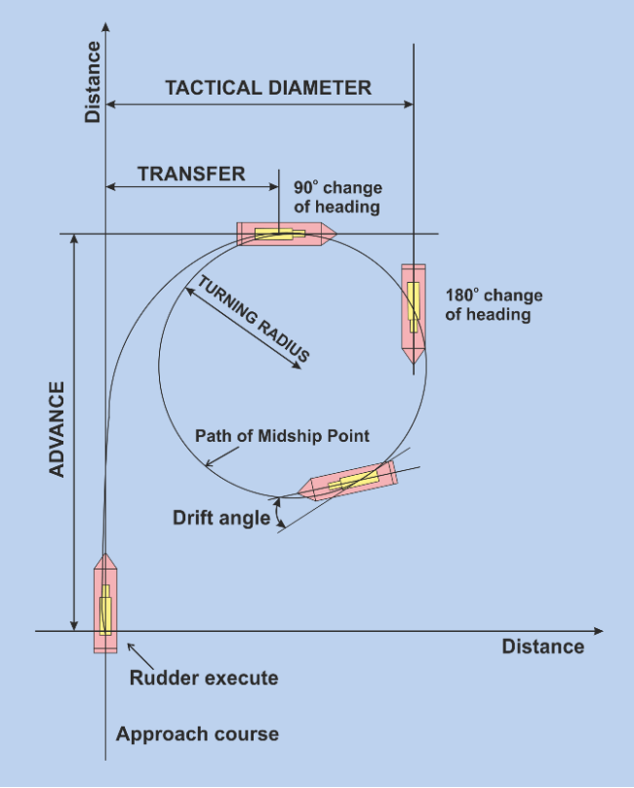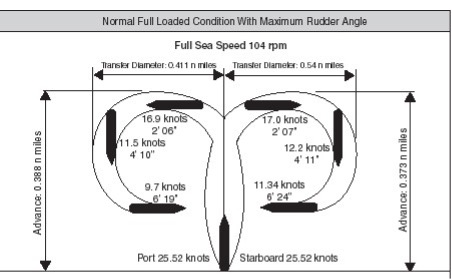The ship’s turning circle has it is own characteristics that influence maneuverability and must be taken into account.
Maneuvering is the term used to describe the process by which a ship’s movement is controlled when in close proximity to other ships and objects at sea or as it approaches or exits a country’s coastal waters, or arrives at or departs from a port’s berth or dock.
All these maneuvers depend on the ship’s turning ability, which is a component of the turning circle of a ship.
The turning circle of a ship, or the diameter of the smallest circle it can make at full speed, is a key aspect of maritime navigation. It determines how long the ship will take to make a U-turn, turn around in its own length, or change course and is, therefore, a measure of the ship’s ability to avoid immediate danger.
The path described by the ship’s pivot point as it moves through a full 360 degrees under full helm is known as the turning circle of a ship. It is a metric for determining how maneuverable a vessel is.
Water resistance, inertia, and propeller thrust are three key concepts that determine a vessel’s turning circle, regardless of its size or shape. The length, beam, draft, displacement, and center of gravity of a ship, as well as the propellers and rudder, all influence the turning circle.
Parts Of Turning Circle
A typical merchant ship turns in a circle, having a diameter of 3–4 times the length between perpendiculars (LBP). The turning circle diameter will be less the larger the rudder (TCD). The ship will undergo transfer, advance, drift angles, and angle of the heel during the TCD maneuver (see Figure). Because of transverse thrust, right-handed propellers have a tighter turning circle when turning to port.
The maneuverability aspects of the ship are tested at the sea trials finalizing the shipbuilding process to ensure that the ship can safely navigate under worst-case scenarios.
The turning circle trial is conducted with the ship at full speed and the rudder helm set at 35°. The ship is turned completely through 360° with the Starboard helm and then with the Port helm (see Figure). The following maneuvering characteristics are obtained from the ship’s turning circle:
Advance
Advance is the distance the ship surges forward once the rudder angle is applied till the ship heading is 900 off course. Proper sea-handling features necessitate a faster response time to an operator command. Though there are no hard and fast standards, minimum advance criteria are always sought for a given ship type and speed.

Transfer.
It is the distance between the ship’s original direction vector and the point at which it has fully turned to starboard/port in its second phase of the turn.
Tactical Diameter.
This is a measurement of how much a vessel can turn. As a result, it is defined as the distance between the ship’s original direction vector at a steady heading and that in the final phase of its turn when a steady state is reached, i.e. the ship has changed its heading by 180 degrees.
This length, in other words, determines the distance negotiated in a complete turnaround with continuous rudder deflection. Tactical Diameter refers to the distance nearly equal to its path’s geometric diameter.
Similarly, the smallest tactical diameters are sought since shipowners want their ship to be as safe as possible to avoid collisions and perform movements as quickly as feasible! Thus an efficient ship should take minimum time to cover its advance and tactical diameter

It should be mentioned that the International Maritime Organization (IMO) has its own yardsticks, (IMO resolution MSC.137(76) “Standards for Ship Manoeuvrability”), for determining the maximum permitted limits of turning ability for a ship, failing which the entire design is scrapped and subjected to review. These are the following:
- First, the Tactical diameter has to be at most less than five times the ship length for any standard merchant ship or passenger service vessel.
Td < 5*Length of Ship- Second, the forward advance has to be less than 4.5 times the length of the ship for any general-purpose vessel.
Ad<4.5*Length of ship.Additional Considerations Under Ship Maneuverability
Course-keeping ability
The ability of a steered ship to maintain a straight path in a predetermined course direction without excessive rudder or heading oscillations are referred to as course-keeping ability. Where there is an inherent dynamic instability of low magnitude, reasonable course control is still attainable in most circumstances.
Initial turning/course-changing ability.
The initial turning ability is measured in terms of heading deviation per unit distance sailed or the distance traveled before realizing a certain heading deviation in response to a modest helm
Yaw checking ability
In a normal zig-zag maneuver, the yaw checking ability of the ship is a measure of the responsiveness to the counter-rudder applied in a certain state of turning, such as the heading overshoot reached before the counter-rudder has canceled the yawing tendency.
Turning ability
The ability to turn the ship using hard over the rudder is measured by turning ability. As a result, the “transfer at 180° change of direction” defines a minimal “advance at 90° change of heading” and “tactical diameter.”
Stopping ability
After a steady approach at full test speed, the “track reach” and “time to dead in water” realized in a stop engine-full astern maneuver are measured.
The Importance of Ship Maneuvering Characteristics.
Maneuverability is described as a vessel’s ability to adjust its route or path. Because a ship must endure extended trips in a variety of weather situations, it is critical that its performance throughout the day-to-day aspects of its voyage is not jeopardized on:
- Turning around an obstacle such as a landmass or any other type of maritime vehicle.
- Circling a particular point of interest.
- Surging, braking, and speeding up.
- Keeping or changing its route or direction.
- Staying on a predetermined path/trajectory.
- The ability to quickly swerve away from an item (ship, iceberg, continent, reef, etc.) without incurring significant time costs.
A navigator’s understanding of the turning circle is critical since these measurements indicate whether there is enough sea room for the ship to avoid the danger being encountered.
For example, a ship handler should know how long it will take for a vessel to take all way off from a full forward position, as well as how far the vessel will move in a turn. The information provided by turning circles and stopping distance (speed trials) is critical for those in charge of today’s ships.
Conclusion.
A navigator’s understanding of the turning circle is critical because these measurements indicate whether there is enough sea room to take necessary evasive action for anti-collision maneuvers.
For example, a ship handler should be aware of how long it will take for a vessel to come to a complete halt in the water from a full forward position, as well as how far the vessel will move in a turn. The information provided by turning circles and stopping distance (speed trials) is critical for those in charge of today’s ships.
- Types of Gas Carriers as per IGC Code – April 22, 2025
- Wind-Assisted Propulsion Systems (WAPS): A Game Changer for Maritime Decarbonization – February 6, 2025
- 10 Boat Salvage Yards in California – January 25, 2025



